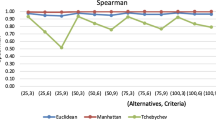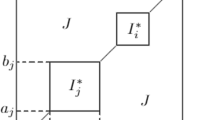Abstract
Beyond its mathematization, preference intensity is a relevant concept, more general than cardinal representable preference, and an according axiomatic definition is introduced, dispensing with the Archimedean assumption. Given a preference intensity, a uniform space (generating the order topology of the induced preference) is associated to it. If the preference intensity is representable, this uniformity is semimetrizable. A “uniqueness” result for preference intensities leads naturally to the hypothesis of compactness. Through the uniformity corresponding to the preference intensity, compactness can be characterized.
Similar content being viewed by others
References
Alcantud JCR (1999) Topological properties of spaces ordered by preferences. Int J Math Math Sci 22:17–27
Alcantud JCR, Gutiérrez JM (1999) Preference through indifference: a topological approach. J Math Econ 31:543–551
Basu K (1983) Cardinal utility, utilitarianism, and a class of invariance axioms in welfare analysis. J Math Econ 12:193–206
Birkhoff G (1940) Lattice theory, 3rd edn. AMS, Providence
Bridges DS, Mehta GB (1995) Representations of preference orderings. Springer, Berlin
Cantor G (1895) Beiträge zur Begründung der transfiniten Mengenlehre. Math Ann 46:481–512
Eilenberg S (1941) Ordered topological spaces. Am J Math 63:39–45
Fishburn PC (1970) Utility theory for decision making. Wiley, New York
French S (1988) Decision theory: an introduction to the mathematics of rationality. Ellis Horwood, Chichester
Gronau D (2000) A remark on Sincov’s functional equation. Not South Afr Math Soc 31:1–8
Krantz DH, Luce RD, Suppes P, Tversky A (1971) Foundations of measurement, vol I. Academic Press, San Diego
Mehta G (1983) Ordered topological spaces and the theorems of Debreu and Peleg. Indian J Pure Appl Math 14:1174–1182
Roberts FS (1979) Measurement theory, with applications to decisionmaking, utility, and the social sciences. Reissue edn. Cambridge University Press, Cambridge
Terencio (ca 161 BC) (1991): El Eunuco, in Comedias, Volume I. Latin text and facing Spanish translation, edited and translated by L Rubio. CSIC
Scott D (1964) Measurement models and linear inequalities. J Math Psychol 1:233–247
Weil A (1938) Sur les espaces à structure uniforme et sur la topologie générale. Hermann, Paris
Wilansky A (1970) Topology for analysis. Reissue edn. Dover Publications, New York
Acknowledgements
The useful suggestions provided by the referees are gratefully acknowledged.
Author information
Authors and Affiliations
Corresponding author
Rights and permissions
About this article
Cite this article
Gutiérrez, J.M. Preference intensity and cardinality. TOP 22, 739–748 (2014). https://doi.org/10.1007/s11750-013-0290-z
Received:
Accepted:
Published:
Issue Date:
DOI: https://doi.org/10.1007/s11750-013-0290-z




